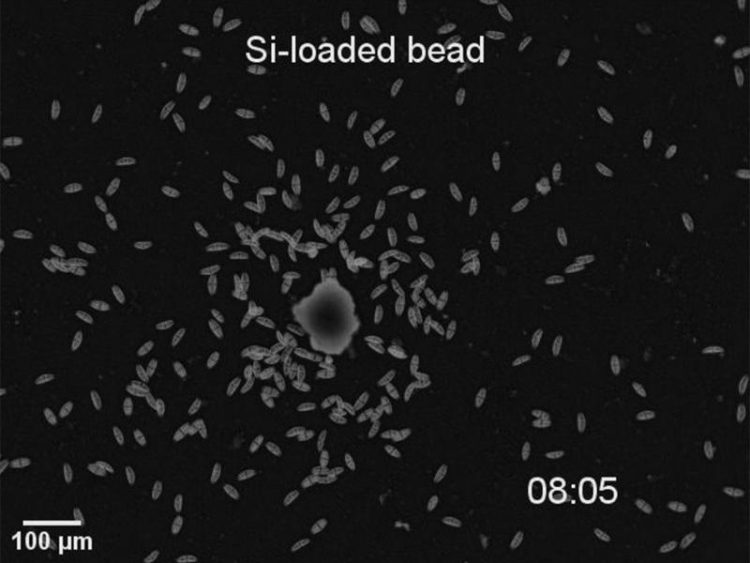Sex or food? Decision-making in single-cell organisms

Diatom cells aggregate around a silicate-loaded bead. I Karen Grace Bondoc, FSU Jena
Diatoms are unicellular microalgae. They dominate marine phytoplankton, which is ubiquitous in our oceans. On shores and beaches, these algae can be observed as biofilms on rocks and other surfaces.
Diatoms are not only the food source for many marine animals, but also responsible for an extremely important ecosystem service: They contribute significantly to global photosynthesis and thus to the production of oxygen on our planet. Moreover, they are discussed as possible produces of biofuels.
The diatom Seminavis robusta is an ideal model organism for behavioral studies in the lab: The cells respond to different environmental conditions and their sexuality can be controlled. The research group of Georg Pohnert, who is Professor of Instrumental Analytics/Bioorganic Analytics at Friedrich Schiller University and head of the Max Planck Fellow Group at the Max Planck Institute for Chemical Ecology, wanted to know whether the tiny organisms are able to make decisions about what they needed more urgently: food or sexual mates.
In order to find out, the scientists cultivated cells under different conditions. In particular, the cells were confronted with different amounts of nutrients and sex pheromones. Since diatoms primarily reproduce asexually by cell division, sexual reproduction may become necessary for their survival if the cells become smaller and smaller after continuous division.
After all, the cells die if they become too small and fall below a minimum size. Diatoms also search actively for nutrients they need for the formation of their cell walls. They can trace silicate minerals in their environment and move actively towards this food source. A recent study showed that they are attracted by the odor of the minerals (see press release The odor of stones, February 4, 2016).
“It is striking that even unicellular organisms that obviously lack a nervous system can process different stimuli and even evaluate their individual needs. Our study showed that diatoms can adapt their behavior flexibly to environmental changes.
They also responded differently depending on their need to sexually mate. We observed that the diatoms moved towards pheromones or food sources depending on how hungry they were for sex or nutrients. Until now, this kind of decision-making has only been attributed to higher organisms,” study leader Georg Pohnert summarizes the results.
The decision of one diatom does not only determine the fate of a single cell. Moreover, it is crucial for the dynamics of biofilms which is composed of communities of countless diatoms. Using mathematical models, the researchers calculated interactions between cell density and the availability of nutrients (silicate minerals) and mating partners (pheromones). Based on these results, the scientists are able to better explain how biofilms are organized and why they are often patchy and show certain patterns.
The scientist would now like to find out how the single-cell organisms perceive, process and evaluate chemical signals. “Our goal is to identify the corresponding receptors and signal processing pathways, but this will be a very complex endeavor given the fact that we know so little about these important micoralagae,” says Georg Pohnert.
Kontakt und Bildanfragen:
Angela Overmeyer M.A., Max-Planck-Institut für chemische Ökologie, Hans-Knöll-Str. 8, 07743 Jena, Tel. +49 3641 57-2110, E-Mail overmeyer@ice.mpg.de
Download des Videos und hochaufgelösten Bildern über www.ice.mpg.de/ext/downloads2018.html
Prof. Dr. Georg Pohnert, Institut für Anorganische und Analytische Chemie, Friedrich- Schiller-Universität Jena, Lessingstraße 8, 07743 Jena, Tel. +49 3641 94-8170, E-Mail Georg.Pohnert@uni-jena.de
Bondoc, K. G. V., Lembke, C., Lang, S. N., Germerodt, S., Schuster, S., Vyverman, W., Pohnert, G. (2018). Decision-making of the benthic diatom Seminavis robusta searching for inorganic nutrients and pheromones. The ISME Journal. DOI: 10.1038/s41396-018-0299-2
https://doi.org/10.1038/s41396-018-0299-2
Media Contact
All latest news from the category: Life Sciences and Chemistry
Articles and reports from the Life Sciences and chemistry area deal with applied and basic research into modern biology, chemistry and human medicine.
Valuable information can be found on a range of life sciences fields including bacteriology, biochemistry, bionics, bioinformatics, biophysics, biotechnology, genetics, geobotany, human biology, marine biology, microbiology, molecular biology, cellular biology, zoology, bioinorganic chemistry, microchemistry and environmental chemistry.
Newest articles

First-of-its-kind study uses remote sensing to monitor plastic debris in rivers and lakes
Remote sensing creates a cost-effective solution to monitoring plastic pollution. A first-of-its-kind study from researchers at the University of Minnesota Twin Cities shows how remote sensing can help monitor and…

Laser-based artificial neuron mimics nerve cell functions at lightning speed
With a processing speed a billion times faster than nature, chip-based laser neuron could help advance AI tasks such as pattern recognition and sequence prediction. Researchers have developed a laser-based…

Optimising the processing of plastic waste
Just one look in the yellow bin reveals a colourful jumble of different types of plastic. However, the purer and more uniform plastic waste is, the easier it is to…



